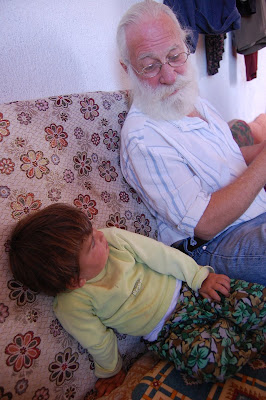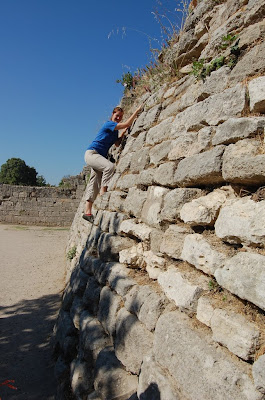
After Konya, the profs arranged with Mehmet from the carpet shop for us to go to a mountain village where he was from and stay with families there. We drove to the village in a small van and it took us 2 hours to get there driving through plains, valleys and mountains, and passing many small villages along the way. The first night I wrote a summary of what I did the first day:
We arrived in the village at about 1. It took us a good two hours to get here from Konya, most of it through back roads. We passed many small villages on the way here, but the place we stopped at was literally the end of the road – there are no more villages after it. We unloaded our stuff and then got back on the bus to go to picnic we had planned. The bus took us on the road to a rocky bluff, where we found a formation of rocks to eat on. After eating, we hiked around a bit, climbing to a cliff where there was a dramatic view of the valley below. We were standing on the Taurus mountains, which wind their way up central Turkey, and so from our viewpoint we could see some really tall mountains still covered with snow.
Clayton on the cliff overlooking the valley below:Climbing around the cliffs:
After coming back from the picnic, we took the bus and got to where we had left our belongings. The people there were laying out rugs – Turkish rugs and kilims are among the most famous in the world – in order to fade them out a bit. Carpets can be laid out for several weeks or months, depending on how much fading you want for the carpet. Apparently, in previous years as many as 4000 carpets are laid out at one time, covering the hillsides. Now, though, only 300 carpets were being laid out, a consequence of young people leaving the villages where weavers traditionally come from to move to big cities like Konya and Istanbul.
Muammer, who organized the trip for us, brought a few carpets for us to sit on, and some nice Turkish women served us tea. After sitting around for a bit, we finally received room assignments – two of the girls and William and Prof Shields would stay in one house, the other four girls would stay in another house, Edward and Clayton would stay in one house, and Kevin and I would each stay in separate houses. This surprised us, since we all expected to stay in pairs, but it was fine with me.
Unfortunately, I was kind of disappointed with the home I stayed in – I’m very grateful for Bekir and his wife having opened up their home to me, but I really wanted to be able to interact more with a family. Instead, the couple I stayed with were older and had four sons, three of whom were living in Konya and one in Poland. The wife didn’t really stick around and I ended up seeing her only when she brought food in; the husband was nice but not a very good talker, so we ended up having a lot of awkward moments. I would try saying something in Turkish, and he would either respond in something I didn’t understand, or would laugh. Needless to say, our conversations didn't go very far.
The house I stayed in:
And the bathroom, which was across the street, non western and not working. I tried to spend as little time there as possible:
 The village:
The village:
After a while, I decided to go walk outside, where I heard some kids playing. I watched them play soccer for a while before I was approached by a nice man named Memed, who invited me to sit with him. I introduced myself as an American student travelling around Turkey, and pretty soon some other guys came up and started talking to me. Everyone was extremely friendly, and one of them even brought a bowl of cherries for me to eat. I got out a bag of candy I had bought for kids and offered it to everyone, which seemed to make them happy. We talked a little more and then I decided to start playing soccer with the kids. They kind of mismatched the teams, with me and two others on one side and five on the other, but it was still fun. After working up a sweat, I stopped playing and then started taking pictures of the kids, which they seemed to like.
After that, I was told to come to dinner. I ate with Bekis a somewhat awkward meal consisting of potato soup, spicy pilav, salad, yogurt, ayran, watermelon, and something that seemed to be a mix of eggplant and lamb’s stomach. I didn’t enjoy that last one so much. After dinner, I was led by Bekis to the house where the rest of the Americans had assembled, and we each discussed our experiences thus far while drinking tea. The people in the other houses (they had all come there too) seemed to be very nice, and from what I heard, everyone was having a good time. I came back with Bekis at around midnight and saw that they prepared a bed for me in one of the rooms. I said my iyi geceler (good night) and headed to bed.
The second day, I woke up at around 8 and ate breakfast with Bekir again. Muammer called me at the house number and I walked up with Bekir to the original place where all the carpets were laid out. There I met up with Kelly, Zoe, William and Prof Shields and a group of Turks. They ate breakfast while took pictures and played with one of the cutest toddlers in the world: The and William sharing a moment:
The and William sharing a moment:
After that, Muanmer took Zoe, Kelly and I to a farm to pick cherries with one of the guys they had eaten breakfast with. We drove to the orchard and started picking some delicious looking cherries. The first few buckets we picked were "male cherries", which are yellow and help pollinate the other cherries. We also picked a few buckets of red Kiraz cherries. They were all delicious. I asked Muammer if they used pesticides on the cherries and he said that they did but used them infrequently because the climate so conducive to good growing.



View from the cherry orchard:

After the cherries, we went to eat lunch and afterwards were taken down into the big valley we'd seen the day before to go swimming at another waterfall. It was beautiful:

We walked and hiked around the waterfall in our bathing suits and even went behind the waterfall into a cave. The current was really strong, so we couldn't really swim like we had in Egirdir, but we still had fun. We ate peaches that some of the other girls had picked and Muammer cut a watermelon for us.
After a while, we decided to head back. I had a quiet dinner with Bekir, then headed to Kevin's house and drank tea with his family. They were all very nice, and their son Mustafa Kemal (named after THE Mustafa Kemal) was very cute. I watched a Turkish version of Deal or No Deal, and then headed to the girls' place and stayed there for a while. After that, it was back to Bekir's house - except when I got there, they were not there. I momentarily panicked as I tried opening the door but was rescued by Kevin and his host, who had come to get me to tell me that Bekir was still at their place. The Turks all thought it was very funny.
We left the next morning, and Bekir was nice enough to get me a couple of bottles of soda water for the trip. Overall, it was definitely an experience that I won't forget, and it gave me a lot of insight about the way people actually live out in the small vilalges that most tourists don't even notice.













































